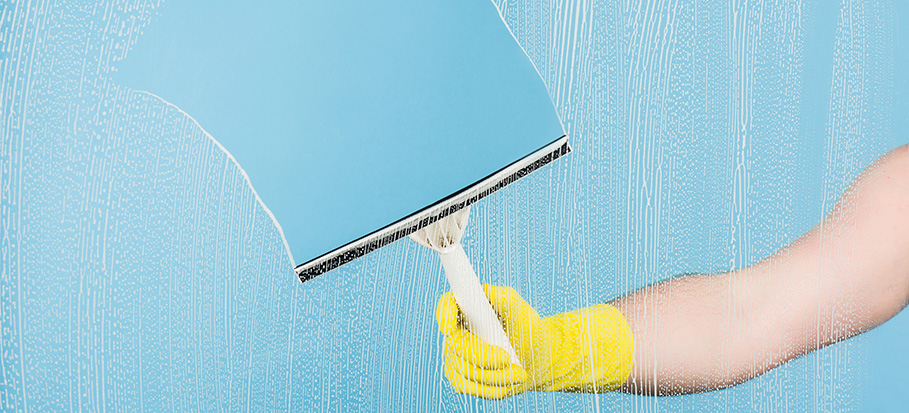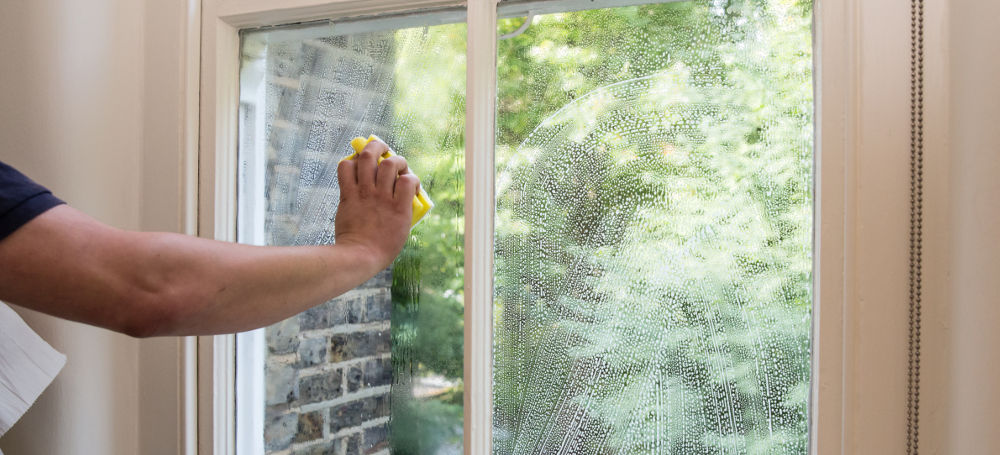The Absolute Beginner’s Guide to Window Cleaning
Cleaning the windows is not a job that features high on a list of priorities for many homeowners but the truth of the matter is that it really isn’t that difficult but can be rather time-consuming if you’re trying to do the whole house.
Get the Right Tools
The first step is to get hold of the right tools for the job. You won’t go far wrong if you include a good squeegee in your window cleaning arsenal and remember to keep it fitted with a new rubber blade. They aren’t very expensive and are regularly used by many window cleaning professionals. You’ll also need a scraper, bucket, washing up liquid, lint-free rags or some small towels. When you buy your squeegee make sure you buy a few replacement rubber blades at the same time as it’ll pay dividends to regularly replace the blade.
Cleaning Windows in 7 Easy Steps
First make up a solution of water and washing liquid. 1 teaspoon to 2 gallons of water is plenty. Dip the scrubber into the solution and squeeze out the excess water.
Scrub the glass back and forth, working into all the corners and make sure you cover every inch of the pane.
With the squeegee start cleaning a narrow strip of the glass. Hold the squeegee so that just one corner contacts and work your way vertically down the side of the window. This narrow strip will make it much easier to start working horizontally.
Now press the whole of the squeegee blade against the glass and starting in the top corner pull it across the window in one steady, fluid movement. Keep the top of the squeegee running along the top of the window.
After every stroke, wipe the squeegee with a clean towel or the scrubber to remove excess water and dirt.
When you run the next stroke across the window overlap it by about 2 inches and angle it so the water runs down the window. Wipe the blade and continue down the window.
Once you’ve worked your way down the window use a rag to wipe any excess water along the window’s bottom edge. Then with your finger pushed into a dry spot wipe the lint free rag around the edge of the window. If you spot some streaks then wipe them off using a clean, dry area of the lint-free rag and change it for a clean one when it gets too wet to be effective.
This method is very good for the external surfaces of your windows but a squeegee can also be used indoors. Professional windows cleaners always use a scrubber and squeegee and the trick when working indoors is to squeeze excess water out of the scrubber to prevent too many drips. After a while, you will need to rinse out the scrubber but it really depends on how dirty your windows are. You might be able to clean as many as 10 windows before it needs a clean. Keep a rag tucked into your pocket to wipe excess water from the squeegee and rest your tools on the edge of your bucket rather than putting them in the water to soak.

Working at height whilst window cleaning
What the law says
The Health and Safety at Work etc. Act 1974 (HSW Act) requires employers to ensure, so far as is reasonably practicable, the health, safety and welfare of their employees and to ensure that those affected by their activities are not exposed to risk. Health and safety law also applies to self-employed window cleaners if their work exposes others to risk.
The Work at Height Regulations 2005 require employers and those in control of any work at height activity to ensure that the work is properly planned, supervised and carried out by competent people. This includes using the right type of equipment for working at height. When planning and organising window cleaning you must avoid work at height where it is reasonably practicable to do so, for example by using telescopic water fed poles or cleaning windows from the inside.
Where window cleaning at height cannot be avoided, you must first consider using an existing place of work that is already safe for example, cleaning from inside windows or from a balcony. If you cannot find an existing safe place, to work from, you must provide suitable access equipment. Where the risk of falling is not eliminated by either of these means, you must take additional measures to minimise the distance and consequences of any fall by using the right type of fall arrest equipment.
It is important to discuss all window cleaning activities with the client as they will know their business well. Working together to develop an agreed co-ordinated approach is essential for reducing the risks e.g. your client will be aware if window/building design allows for safe cleaning of windows from the inside effectively eliminating the risk of falling.
All those working at height must have the right skills, knowledge and experience. The requirements for specific competences will depend on the work being done, e.g. a window cleaner involved in abseiling will require different skills, knowledge and experience from someone only involved in cleaning ground floor windows.

A guide for window cleaners
Establish a seamless sign up process
Before approaching customers you’ll need to make sure that you have a seamless system in place to allow customers to sign up to Direct Debit. Whether that’s asking them to enter their details on your website, entering them on a tablet while speaking to them on the doorstep, or emailing them a link to pay, making this process easy takes away any friction and gets customers set up more quickly.
Explain how Direct Debit works
It’s important to emphasise that these Direct Debit payments will only be taken when a clean has been completed, unlike a monthly Direct Debit for a phone contract or energy bill, for example. So, if you clean a customer’s windows twice a year they will only see two payments annually. “If I don’t do the clean then I won’t take the payment,”
You can also explain to your customers that any payments will be protected under the . Under the guarantee, customers can request a refund for any payment they believe was taken in error, they also have to be notified before a payment is taken.
Explain how it will make customers’ lives easier
You will have already started to see the benefits that using brings to your business: no more chasing payments or unpaid bills and no more evening cash collections or hours checking for customer payments on your online banking. But Direct Debit doesn’t just benefit your business, there are a whole host of advantages for customers too.
Offer an incentive
Given the time and cost -saving benefits, you may want to pass some of these savings on to your customers as an incentive to sign-up, for example a free or discounted window clean.

How to Clean Windows: Handy Tips and Tricks for a Brighter View
How easy would it be if there was some magic trick to make your windows gleam with just the snap of your fingers? Sadly, we don’t live in an alternate universe of fairy tales. We need to do some work in order to get the shiny look back to our windows. Perhaps you’re wondering how often to clean your windows. Or maybe you want to know what the best way to wash windows is. Either way, the professional window cleaners at Fantastic Services have the answers.
If you:
Are thinking of cleaning your windows;
Want to know what common mistakes to avoid;
Are interested in the benefits of professional window cleaning,
Then keep reading! This article is for you.
How to clean your windows
Let’s start with the tools you’ll need:
White vinegar
Water
Spray bottle
Small bucket
Microfibre cloth
Mop/window scrubber
Sponge
Squeegee
Clean towel
Cleaning windows doesn’t have to be a tough job. Follow these simple steps to a clearer view:
Choose the right time.
Pick a time when the sun isn’t falling directly onto the windows. Otherwise, the solution will dry out quickly, leaving unpleasant streaks.
Remove curtains, blinds and window screens.
You’ll clean them separately later.
Prepare a cleaning solution.
Mix an eco-friendly window cleaning solution of equal parts warm water and white vinegar. Fill up one spray bottle and a small bucket with the mixture.
Spray.
Spray down the window from top to bottom. Make sure it’s soaking wet.
Wipe the frame.
Wipe down the frame first. Don’t skip this step, otherwise, all the dust and grime from the frame will get across the spotless glass.
Scrub the glass.
Scrub the window gently with a mop or a window scrubber. That’s how you agitate all dust, dirt and stubborn stains and make them easier to remove.
Rinse.
Soak up the sponge in the bucket and rinse the window thoroughly.
Scrape.
Use a squeegee to scrape the solution off the glass with a fluid motion. You can either squeegee the window from top to bottom or you can use the professional “S” technique.
Wipe.
Grab a clean towel and wipe the edges of the window frame and sills so there’s no water dripping. Wipe the blade of the squeegee from time to time to avoid streaks on the glass.
Dry.
Dry up the window with a microfibre cloth for a gleaming appearance before moving to the next one.
How often should you clean your windows?
Experts recommend that you clean your windows every four to eight weeks.
Window Cleaning Field Safety Guide
How to use this guide.
The purpose of this field guide is to provide you with a list of the major recognized safety hazards which may be encountered during professional window cleaning. This field guide also provides some of the key best practices to address these hazards and help you stay safe on the job.
One of the most important steps to keeping workers safe on the job is to perform a site assessment before starting work at a site. The site assessment should identify the safety and health hazards workers may encounter at a particular location.
This section identifies the major workplace hazards faced by window cleaning workers that should be evaluated as part of the site assessment. See the following sections for how to address those hazards.
The following are some of the hazards that the window cleaning contractor should review as part of the site assessment:
A. Weather
Professional window cleaning requires you to work outside much of the time. Be aware of things such as extreme temperatures, windy conditions, and inclement weather conditions.
B. Chemicals
Window cleaners may be exposed to a variety of chemicals in the cleaning products they use. Consider what chemicals you will be using and be sure that you are equipped with the necessary information and appropriate PPE.
C. Falls from Heights
Be aware of changes in elevation of walking or working surfaces that are greater than four feet in the work area and which are not protected by a guardrail or structure that is 42 inches or taller. These hazards may include things such as scaffolds, skylights, and different roof levels when working at elevated heights, and things such as retaining walls, balconies, and unprotected holes when working on the ground.
D. Ladders
Be aware of the jobsite conditions under which you will be using a ladder, and be sure that the type of ladder that you are planning to use is appropriate for use under those conditions.
E. Slips, Trips and Falls
Be aware of the conditions of the surfaces on which you will be walking, regardless of whether the surface is elevated or on the ground, and be sure that you are aware of any conditions that could present a slip, trip, or fall hazard.
F. Electrical
Be aware of the presence of exposed outlets, electrical fixtures, and power lines in the work area.
G. Tools & Equipment
Consider the types of tools and equipment that you plan to use, and be sure that they are appropriate for use under the conditions present at the jobsite.
H. Building Occupants, Co-Workers, and the Public
In most types of window cleaning work, occupants, co-workers, or other members of the public may be present at the job site. Be aware of how your work and work area may affect others, and make provisions to protect them from being negatively impacted by your work.